| Komodo dragon[1] | |
|---|---|
 | |
| Conservation status | |
| Scientific classification | |
| Kingdom: | Animalia |
| Phylum: | Chordata |
| Class: | Reptilia |
| Order: | Squamata |
| Suborder: | Lacertilia |
| Family: | Varanidae |
| Genus: | Varanus |
| Subgenus: | V. (Varanus) |
| Species: | V. komodoensis |
| Binomial name | |
| Varanus komodoensis Ouwens, 1912[2] | |
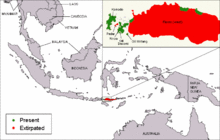 | |
| Komodo dragon distribution | |
The Komodo dragon (Varanus komodoensis) is a large species of lizard found in the Indonesian islands of Komodo, Rinca, Flores, Gili Motang and Gili Dasami.[3] A member of the monitor lizard family (Varanidae), it is the largest living species of lizard, growing to a maximum of length 3 metres (9.8 ft) in rare cases and weighing up to around 70 kilograms (150 lb).[3] Their unusual size has been attributed to island gigantism, since there are no other carnivorous animals to fill the niche on the islands where they live.[4][5] However, recent research suggests that the large size of komodo dragons may be better understood as representative of a relict population of very large varanid lizards that once lived across Indonesia and Australia, most of which, along with other megafauna,[6] died out after the Pleistocene. Fossils very similar to V. komodoensis have been found in Australia dating to greater than 3.8 million years ago, and its body size remained stable on Flores, one of the handful of Indonesian islands where it is currently found, ever since Flores (along with neighboring islands) were isolated by rising sea levels approximately 900,000 years ago.[6] As a result of their size, these lizards dominate the ecosystems in which they live.[7] Komodo dragons hunt and ambush prey including invertebrates, birds, and mammals. The diet of big Komodo dragons mainly consists of deer, though they also eat considerable amounts of carrion.[3]
Mating begins between May and August, and the eggs are laid in September. About twenty eggs are deposited in abandoned megapode nests or in a self-dug nesting hole.[3] The eggs are incubated for seven to eight months, hatching in April, when insects are most plentiful. Young Komodo dragons are vulnerable and therefore dwell in trees, safe from predators and cannibalistic adults. They take about eight to nine years to mature, and are estimated to live for up to 30 years.[3]
Komodo dragons were first recorded by Western scientists in 1910.[8] Their large size and fearsome reputation make them popular zoo exhibits. In the wild their range has contracted due to human activities and they are listed as vulnerable by the IUCN. They are protected under Indonesian law, and a national park, Komodo National Park, was founded to aid protection efforts.
Contents[hide] |
Etymology
The Komodo dragon is also known as the Komodo monitor or the Komodo Island monitor in scientific literature, although this is not very common.[1] To the natives of Komodo Island, it is referred to as ora, buaya darat (land crocodile) or biawak raksasa (giant monitor).[9][10]
Evolutionary history
The evolutionary development of the Komodo dragon started with the Varanus genus, which originated in Asia about 40 million years ago and migrated to Australia. Around 15 million years ago, a collision between Australia and Southeast Asia allowed the varanids to move into what is now the Indonesian archipelago, extending their range as far east as the island of Timor. The Komodo dragon was believed to have differentiated from its Australian ancestors 4 million years ago. However, recent fossil evidence from Queensland suggests that the Komodo dragon evolved in Australia before spreading to Indonesia.[6][11] Dramatic lowering of sea level during the last glacial period uncovered extensive stretches of continental shelf that the Komodo dragon colonized, becoming isolated in their present island range as sea levels rose afterwards.[6][10]
Description
In the wild, an adult Komodo dragon usually weighs around 70 kilograms (150 lb),[12] although captive specimens often weigh more. The largest verified wild specimen was 3.13 metres (10.3 ft) long and weighed 166 kilograms (370 lb), including undigested food.[10] The Komodo dragon has a tail as long as its body, as well as about 60 frequently replaced serrated teeth that can measure up to 2.5 cm (1 inch) in length. Its saliva is frequently blood-tinged, because its teeth are almost completely covered by gingival tissue that is naturally lacerated during feeding.[13] This creates an ideal culture for the virulent bacteria that live in its mouth.[14] It also has a long, yellow, deeply forked tongue.[10]
Senses
The Komodo dragon does not have an acute sense of hearing, despite its visible earholes, and is only able to hear sounds between 400 and 2000 hertz.[10][15] It is able to see as far away as 300 metres (980 ft), but because its retinas only contain cones, it is thought to have poor night vision. The Komodo dragon is able to see in color, but has poor visual discrimination of stationary objects.[16]
The Komodo dragon uses its tongue to detect, taste, and smell stimuli, as with many other reptiles, with the vomeronasal sense using the Jacobson's organ.[14] With the help of a favorable wind and its habit of swinging its head from side to side as it walks, Komodo dragons may be able to detect carrion from 4–9.5 kilometres (2.5–6 mi) away.[13][16] The dragon's nostrils are not of great use for smelling, as the animal does not have a diaphragm.[13][17] It only has a few taste buds in the back of its throat.[14] Its scales, some of which are reinforced with bone, have sensory plaques connected to nerves that facilitate its sense of touch. The scales around the ears, lips, chin, and soles of the feet may have three or more sensory plaques.[13]
The Komodo dragon was formerly thought to be deaf when a study reported no agitation in wild Komodo dragons in response to whispers, raised voices, or shouts. This was disputed when London Zoological Garden employee Joan Proctor trained a captive specimen to come out to feed at the sound of her voice, even when she could not be seen.[18]
Ecology
The Komodo dragon prefers hot and dry places, and typically lives in dry open grassland, savanna, and tropical forest at low elevations. As an ectotherm, it is most active in the day, although it exhibits some nocturnal activity. Komodo dragons are solitary, coming together only to breed and eat. They are capable of running rapidly in brief sprints up to 20 kilometres per hour (12.4 mph), diving up to 4.5 metres (15 ft), and climbing trees proficiently when young through use of their strong claws.[12] To catch prey that is out of reach, the Komodo dragon may stand on its hind legs and use its tail as a support.[18] As the Komodo dragon matures, its claws are used primarily as weapons, as its great size makes climbing impractical.[13]
For shelter, the Komodo dragon digs holes that can measure from 1–3 metres (3–10 ft) wide with its powerful forelimbs and claws.[19] Because of its large size and habit of sleeping in these burrows, it is able to conserve body heat throughout the night and minimize its basking period the morning after.[20] The Komodo dragon hunts in the afternoon, but stays in the shade during the hottest part of the day.[21] These special resting places, usually located on ridges with a cool sea breeze, are marked with droppings and are cleared of vegetation. They serve as a strategic location from which to ambush deer.[22]
Diet
Komodo dragons are carnivores. Although they eat mostly carrion,[4] they will also ambush live prey with a stealthy approach. When suitable prey arrives near a dragon's ambush site, it will suddenly charge at the animal and go for the underside or the throat.[13] It is able to locate its prey using its keen sense of smell, which can locate a dead or dying animal from a range of up to 9.5 km (6 miles).[13] Komodo dragons have been observed knocking down large pigs and deer with their strong tail.[23][24]
Komodo dragons eat by tearing large chunks of flesh and swallowing them whole while holding the carcass down with their forelegs. For smaller prey up to the size of a goat, their loosely articulated jaws, flexible skull, and expandable stomach allow it to swallow its prey whole. The vegetable contents of the stomach and intestines are typically avoided.[22] Copious amounts of red saliva that the Komodo dragons produce help to lubricate the food, but swallowing is still a long process (15–20 minutes to swallow a goat). A Komodo dragon may attempt to speed up the process by ramming the carcass against a tree to force it down its throat, sometimes ramming so forcefully that the tree is knocked down.[22] To prevent itself from suffocating while swallowing, it breathes using a small tube under the tongue that connects to the lungs.[13] After eating up to 80 percent of its body weight in one meal,[7] it drags itself to a sunny location to speed digestion, as the food could rot and poison the dragon if left undigested for too long. Because of their slow metabolism, large dragons can survive on as little as 12 meals a year.[13] After digestion, the Komodo dragon regurgitates a mass of horns, hair, and teeth known as the gastric pellet, which is covered in malodorous mucus. After regurgitating the gastric pellet, it rubs its face in the dirt or on bushes to get rid of the mucus, suggesting that it, like humans, does not relish the scent of its own excretions.[13]
The largest animals eat first, while the smaller ones follow a hierarchy. The largest male asserts his dominance and the smaller males show their submission by use of body language and rumbling hisses. Dragons of equal size may resort to "wrestling". Losers usually retreat though they have been known to be killed and eaten by victors.[13]
The Komodo dragon's diet is wide-ranging, and includes invertebrates, other reptiles (including smaller Komodo dragons), birds, bird eggs, small mammals, monkeys, wild boar, goats, deer, horses, and water buffalo.[25] Young Komodos will eat insects, eggs, geckos, and small mammals.[4] Occasionally they consume humans and human corpses, digging up bodies from shallow graves.[18] This habit of raiding graves caused the villagers of Komodo to move their graves from sandy to clay ground and pile rocks on top of them to deter the lizards.[22] The Komodo dragon may have evolved to feed on the extinct dwarf elephant Stegodon that once lived on Flores, according to evolutionary biologist Jared Diamond.[26]
Because the Komodo dragon does not have a diaphragm, it cannot suck water when drinking, nor can it lap water with its tongue. Instead, it drinks by taking a mouthful of water, lifting its head, and letting the water run down its throat.[13]
Saliva
Auffenberg described the Komodo dragon as having septic pathogens in its saliva (he described the saliva as "reddish and copious"), specifically the bacteria: E. coli, Staphylococcus sp., Providencia sp., Proteus morgani and P. mirabilis.[27] He noted that while these pathogens can be found in the mouths of wild Komodo dragons, they disappear from the mouths of captive animals, due to a cleaner diet and the use of antibiotics.[27][28] This was verified by taking mucous samples from the external gum surface of the upper jaw of two freshly captured individuals.[27][28] Saliva samples were analyzed by researchers at the University of Texas who found 57 different strains of bacteria growing in the mouths of three wild Komodo dragons including Pasteurella multocida.[10][29] The rapid growth of these bacteria was noted by Fredeking: "Normally it takes about three days for a sample of P. multocida to cover a petri dish; ours took eight hours. We were very taken aback by how virulent these strains were".[30] This study supported the observation that wounds inflicted by the Komodo dragon are often associated with sepsis and subsequent infections in prey animals.[29] How the Komodo dragon is unaffected by these virulent bacteria remains a mystery.[30]
In late 2005, researchers at the University of Melbourne speculated that the perentie (Varanus giganteus), other species of monitor, and agamids may be somewhat venomous. The team believes that the immediate effects of bites from these lizards were caused by mild envenomation. Bites on human digits by a lace monitor (V. varius), a Komodo dragon, and a spotted tree monitor (V. scalaris) all produced similar effects: rapid swelling, localized disruption of blood clotting, and shooting pain up to the elbow, with some symptoms lasting for several hours.[31]
In 2009, the same researchers published further evidence demonstrating that Komodo dragons possess a venomous bite. MRI scans of a preserved skull showed the presence of two venom glands in the lower jaw. They extracted one of these glands from the head of a terminally ill specimen in the Singapore Zoological Gardens, and found that it secreted a venom containing several different toxic proteins. The known functions of these proteins include inhibition of blood clotting, lowering of blood pressure, muscle paralysis, and the induction of hypothermia, leading to shock and loss of consciousness in envenomated prey.[32][33] As a result of the discovery, the previous theory that bacteria were responsible for the deaths of komodo victims was disputed.[34]
Kurt Schwenk, an evolutionary biologist at the University of Connecticut finds the discovery of these glands intriguing, but considers most of the evidence for venom in the study to be "meaningless, irrelevant, incorrect or falsely misleading". Even if the lizards have venomlike proteins in their mouths, Schwenk argues, they may be using them for a different function, and he doubts that venom is necessary to explain the effect of a Komodo dragon bite, arguing that shock and blood loss are the primary factors.[35][36]
Reproduction
Mating occurs between May and August, with the eggs laid in September.[10] During this period, males fight over females and territory by grappling with one another upon their hind legs with the loser eventually being pinned to the ground. These males may vomit or defecate when preparing for the fight.[18] The winner of the fight will then flick his long tongue at the female to gain information about her receptivity.[7] Females are antagonistic and resist with their claws and teeth during the early phases of courtship. Therefore, the male must fully restrain the female during coitus to avoid being hurt. Other courtship displays include males rubbing their chins on the female, hard scratches to the back, and licking.[37] Copulation occurs when the male inserts one of his hemipenes into the female's cloaca.[16] Komodo dragons may be monogamous and form "pair bonds", a rare behavior for lizards.[18]
The female lays her eggs in burrows cut into the side of a hill or in the abandoned nesting mounds of the Orange-footed Scrubfowl (a moundbuilder or megapode), with a preference for the abandoned mounds.[38] Clutches contain an average of 20 eggs which have an incubation period of 7–8 months.[18] Hatching is an exhausting effort for the neonates, who break out of their eggshells with an egg tooth that falls off soon after. After cutting out the hatchlings may lie in their eggshells for hours before starting to dig out of the nest. They are born quite defenseless, and many are eaten by predators.[13]
Young Komodo dragons spend much of their first few years in trees, where they are relatively safe from predators, including cannibalistic adults, who make juvenile dragons 10% of their diet.[18] According to David Attenborough, the habit of cannibalism may be advantageous in sustaining the large size of adults, as medium-sized prey on the islands is rare.[23] When the young must approach a kill, they roll around in fecal matter and rest in the intestines of eviscerated animals to deter these hungry adults.[18] Komodo dragons take about three to five years to mature, and may live for up to 50 years.[19]
Parthenogenesis
A Komodo dragon at London Zoo named Sungai laid a clutch of eggs in late 2005 after being separated from male company for more than two years. Scientists initially assumed that she had been able to store sperm from her earlier encounter with a male, an adaptation known as superfecundation.[39] On December 20, 2006, it was reported that Flora, a captive Komodo dragon living in the Chester Zoo in England, was the second known Komodo dragon to have laid unfertilized eggs: she laid 11 eggs, and 7 of them hatched, all of them male.[40] Scientists at Liverpool University in England performed genetic tests on three eggs that collapsed after being moved to an incubator, and verified that Flora had never been in physical contact with a male dragon. After Flora's eggs' condition had been discovered, testing showed that Sungai's eggs were also produced without outside fertilization.[41] On January 31, 2008, the Sedgwick County Zoo in Wichita, Kansas became the first zoo in the Americas to document parthenogenesis in Komodo dragons. The zoo has two adult female Komodo dragons, one of which laid about 17 eggs on May 19–20, 2007. Only two eggs were incubated and hatched due to space issues; the first hatched on January 31, 2008 while the second hatched on February 1. Both hatchlings were males.[42][43]
Komodo dragons have the ZW chromosomal sex-determination system, as opposed to the mammalian XY system. Male progeny prove that Flora's unfertilized eggs were haploid (n) and doubled their chromosomes later to become diploid (2n) (by being fertilized by a polar body, or by chromosome duplication without cell division), rather than by her laying diploid eggs by one of the meiosis reduction-divisions in her ovaries failing. When a female Komodo dragon (with ZW sex chromosomes) reproduces in this manner, she provides her progeny with only one chromosome from each of her pairs of chromosomes, including only one of her two sex chromosomes. This single set of chromosomes is duplicated in the egg, which develops parthenogenetically. Eggs receiving a Z chromosome become ZZ (male); those receiving a W chromosome become WW and fail to develop.[44][45]
It has been hypothesized that this reproductive adaptation allows a single female to enter an isolated ecological niche (such as an island) and by parthenogenesis produce male offspring, thereby establishing a sexually reproducing population (via reproduction with her offspring that can result in both male and female young).[44] Despite the advantages of such an adaptation, zoos are cautioned that parthenogenesis may be detrimental to genetic diversity.[46]
History
Discovery by the Western world
Komodo dragons were first documented by Europeans in 1910, when rumors of a "land crocodile" reached Lieutenant van Steyn van Hensbroek of the Dutch colonial administration.[47] Widespread notoriety came after 1912, when Peter Ouwens, the director of the Zoological Museum at Bogor, Java, published a paper on the topic after receiving a photo and a skin from the lieutenant, as well as two other specimens from a collector.[2] Later, the Komodo dragon was the driving factor for an expedition to Komodo Island by W. Douglas Burden in 1926. After returning with 12 preserved specimens and 2 live ones, this expedition provided the inspiration for the 1933 movie King Kong.[48] It was also Burden who coined the common name "Komodo dragon."[21] Three of his specimens were stuffed and are still on display in the American Museum of Natural History.[49]
Studies

The Dutch, realizing the limited number of individuals in the wild, outlawed sport hunting and heavily limited the number of individuals taken for scientific study. Collecting expeditions ground to a halt with the occurrence of World War II, not resuming until the 1950s and 1960s, when studies examined the Komodo dragon's feeding behavior, reproduction, and body temperature. At around this time, an expedition was planned in which a long-term study of the Komodo dragon would be undertaken. This task was given to the Auffenberg family, who stayed on Komodo Island for 11 months in 1969. During their stay, Walter Auffenberg and his assistant Putra Sastrawan captured and tagged more than 50 Komodo dragons.[30] The research from the Auffenberg expedition would prove to be enormously influential in raising Komodo dragons in captivity.[50] Research after the Auffenberg family has shed more light on the nature of the Komodo dragon, with biologists such as Claudio Ciofi continuing to study the creatures.[51]
Conservation

The Komodo dragon is a vulnerable species and is found on the IUCN Red List.[52] There are approximately 4,000 to 5,000 living Komodo dragons in the wild. Their populations are restricted to the islands of Gili Motang (100), Gili Dasami (100), Rinca (1,300), Komodo (1,700), and Flores (perhaps 2,000).[50] However, there are concerns that there may presently be only 350 breeding females.[9] To address these concerns, the Komodo National Park was founded in 1980 to protect Komodo dragon populations on islands including Komodo, Rinca, and Padar.[53] Later, the Wae Wuul and Wolo Tado Reserves were opened on Flores to aid with Komodo dragon conservation.[51]
Komodo dragons avoid encounters with humans. Juveniles are very shy and will flee quickly into a hideout if a human comes closer than about 100 metres (330 ft). Older animals will also retreat from humans from a shorter distance away. If cornered, they will react aggressively by gaping their mouth, hissing, and swinging their tail. If they are disturbed further, they may start an attack and bite. Although there are anecdotes of unprovoked Komodo dragons attacking or preying on humans, most of these reports are either not reputable or caused by defensive bites. Only a very few cases are truly the result of unprovoked attacks by abnormal individuals which lost their fear towards humans.[27]
Volcanic activity, earthquakes, loss of habitat, fire,[13][51] loss of prey due to poaching, tourism, and illegal poaching of the dragons themselves have all contributed to the vulnerable status of the Komodo dragon. Under Appendix I of CITES (the Convention on International Trade in Endangered Species), commercial trade of skins or specimens is illegal.[17][54]
On Padar, a former population of the Komodo Dragon became extinct, of which the last individuals were seen in 1975.[55] It is widely assumed that the Komodo dragon died out on Padar after a strong decline of the populations of large ungulate prey, for which poaching was most likely responsible.[56]
In captivity

Komodo dragons have long been great zoo attractions, where their size and reputation make them popular exhibits. They are, however, rare in zoos because they are susceptible to infection and parasitic disease if captured from the wild, and do not readily reproduce.[9] In May 2009, there were 13 European, 2 African, 35 North American, 1 Singaporean, and 2 Australian institutions that keep Komodo dragons.[57]
The first Komodo dragon was exhibited in 1934 at the Smithsonian National Zoological Park, but it lived for only two years. More attempts to exhibit Komodo dragons were made, but the lifespan of these creatures was very short, averaging five years in the National Zoological Park. Studies done by Walter Auffenberg, which were documented in his book The Behavioral Ecology of the Komodo Monitor, eventually allowed for more successful managing and reproducing of the dragons in captivity.[50]
A variety of different behaviors have been observed from captive specimens. Most individuals are relatively tame within a short period of time,[58][59] and are capable of recognizing individual humans and discriminating between more familiar keepers.[60] Komodo dragons have also been observed to engage in play with a variety of objects, including shovels, cans, plastic rings, and shoes. This behavior does not seem to be "food-motivated predatory behavior."[7][10][61]
Even seemingly docile dragons may become aggressive unpredictably, especially when the animal's territory is invaded by someone unfamiliar. In June 2001, a Komodo dragon seriously injured Phil Bronstein—executive editor of the San Francisco Chronicle—when he entered its enclosure at the Los Angeles Zoo after being invited in by its keeper. Bronstein was bitten on his bare foot, as the keeper had told him to take off his white shoes, which could have potentially excited the Komodo dragon.[62][63] Although he escaped, he needed to have several tendons in his foot reattached surgically.[64]
See also
- Dragon
- Papua monitor (Varanus salvadorii) – A monitor lizard often asserted to be the longest lizard
- Toxicofera – A hypothetical clade encompassing all venomous reptiles, including the Komodo dragon
- Varanus priscus (formerly known as Megalania prisca) – A huge extinct varanid lizard of Pleistocene Australia
- Whiptail lizards – Lizards widely studied for their parthenogenesis




 01:39
01:39
 kaniamazdar
kaniamazdar


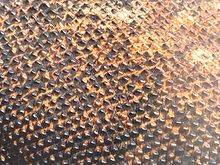







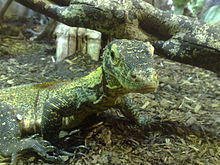
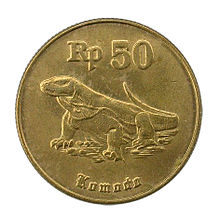
 Although there is mention of 'fabrics highly decorated' in Dutch transcripts from the 17th century, most scholars believe that the intricate Javanese batik designs would only have been possible after the importation of finely woven imported cloth, which was first imported to Indonesia from India around the 1800s and afterwards from Europe beginning in 1815. Textile patterns can be seen on stone statues that are carved on the walls of ancient Javanese temples such as Prambanan (AD 800), however there is no conclusive evidence that the cloth is batik. It could possibly be a pattern that was produced with weaving techniques and not dying. What is clear is that in the 19th century batik became highly developed and was well ingrained in Javanese cultural life.
Although there is mention of 'fabrics highly decorated' in Dutch transcripts from the 17th century, most scholars believe that the intricate Javanese batik designs would only have been possible after the importation of finely woven imported cloth, which was first imported to Indonesia from India around the 1800s and afterwards from Europe beginning in 1815. Textile patterns can be seen on stone statues that are carved on the walls of ancient Javanese temples such as Prambanan (AD 800), however there is no conclusive evidence that the cloth is batik. It could possibly be a pattern that was produced with weaving techniques and not dying. What is clear is that in the 19th century batik became highly developed and was well ingrained in Javanese cultural life. an important source of batik patterns. Wayang puppets are usually made of goat skin, which is then perforated and painted to create the illusion of clothing on the puppet. Used puppets were often sold to eager ladies who used the puppets as guides for their batik patterns. They would blow charcoal through the holes that define the patterns of clothing on the puppets, in order to copy the intricate designs onto the cloth.
an important source of batik patterns. Wayang puppets are usually made of goat skin, which is then perforated and painted to create the illusion of clothing on the puppet. Used puppets were often sold to eager ladies who used the puppets as guides for their batik patterns. They would blow charcoal through the holes that define the patterns of clothing on the puppets, in order to copy the intricate designs onto the cloth. The cloth that is used for batik is washed and boiled in water many times prior to the application of wax so that all traces of starches, lime, chalk and other sizing materials are removed. Prior to the implementation of modern day techniques, the cloth would have been pounded with a wooden mallet or ironed to make it smooth and supple so it could best receive the wax design. With the finer machine-made cotton available today, the pounding or ironing processes can be omitted. Normally men did this step in the batik process.
The cloth that is used for batik is washed and boiled in water many times prior to the application of wax so that all traces of starches, lime, chalk and other sizing materials are removed. Prior to the implementation of modern day techniques, the cloth would have been pounded with a wooden mallet or ironed to make it smooth and supple so it could best receive the wax design. With the finer machine-made cotton available today, the pounding or ironing processes can be omitted. Normally men did this step in the batik process. The wajan is the container that holds the melted wax. It looks like a small wok. Normally it is made of iron or earthenware. The wajan is placed on a small brick charcoal stove or a spirit burner called an 'anglo'. The wax is kept in a melted state while the artisan is applying the wax to the cloth.
The wajan is the container that holds the melted wax. It looks like a small wok. Normally it is made of iron or earthenware. The wajan is placed on a small brick charcoal stove or a spirit burner called an 'anglo'. The wax is kept in a melted state while the artisan is applying the wax to the cloth.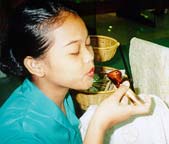 The best waxes are from the Indonesian islands of Timor, Sumbawa and Sumatra; three types of petroleum-based paraffin (white, yellow and black) are used. The amounts mixed are measured in grams and vary according to the design. Wax recipes can be very closely guarded secrets. Varying colors of wax make it possible to disguise different parts of the pattern through the various dying stages. Larger areas of the pattern are filled in with wax that is cheaper quality and the higher quality wax is used on the more intricately detailed sections of the design.
The best waxes are from the Indonesian islands of Timor, Sumbawa and Sumatra; three types of petroleum-based paraffin (white, yellow and black) are used. The amounts mixed are measured in grams and vary according to the design. Wax recipes can be very closely guarded secrets. Varying colors of wax make it possible to disguise different parts of the pattern through the various dying stages. Larger areas of the pattern are filled in with wax that is cheaper quality and the higher quality wax is used on the more intricately detailed sections of the design. Creating batik is a very time consuming craft. To meet growing demands and make the fabric more affordable to the masses, in the mid-19th century the . cap. (copper stamp - pronounced chop) was developed. This invention enabled a higher volume of batik production compared to the traditional method which entailed the tedious application of wax by hand with a canting.
Creating batik is a very time consuming craft. To meet growing demands and make the fabric more affordable to the masses, in the mid-19th century the . cap. (copper stamp - pronounced chop) was developed. This invention enabled a higher volume of batik production compared to the traditional method which entailed the tedious application of wax by hand with a canting.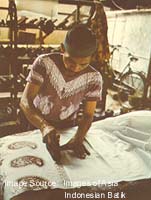 bottom. The block is cut in half at the center so the pattern on each half is identical. Cap vary in size and shape depending on the pattern they are needed for. It is seldom that a cap will exceed 24 cm in diameter, as this would make the handling too difficult.
bottom. The block is cut in half at the center so the pattern on each half is identical. Cap vary in size and shape depending on the pattern they are needed for. It is seldom that a cap will exceed 24 cm in diameter, as this would make the handling too difficult. of the design that the artisan wishes to remain the original color of the cloth. Normally this is white or cream.
of the design that the artisan wishes to remain the original color of the cloth. Normally this is white or cream. If the cap method is utilized, this procedure is normally done by men. The cap are dipped into melted wax. Just under the surface of the melted wax is a folded cloth approximately 30 centimeters square. When this cloth is saturated with wax it acts like a stamp pad. The cap is pressed into the fabric until the design side of the cap is coated with wax. The saturated cap is then stamped onto the fabric, leaving the design of the cap. This process is repeated until the entire cloth is covered. Often cap and canting methods are combined on the same piece of cloth.
If the cap method is utilized, this procedure is normally done by men. The cap are dipped into melted wax. Just under the surface of the melted wax is a folded cloth approximately 30 centimeters square. When this cloth is saturated with wax it acts like a stamp pad. The cap is pressed into the fabric until the design side of the cap is coated with wax. The saturated cap is then stamped onto the fabric, leaving the design of the cap. This process is repeated until the entire cloth is covered. Often cap and canting methods are combined on the same piece of cloth. When the desired color has been achieved and the fabric has dried, wax is reapplied over the areas that the artisan wishes to maintain the first dye color or another color at a later stage in the dying process.
When the desired color has been achieved and the fabric has dried, wax is reapplied over the areas that the artisan wishes to maintain the first dye color or another color at a later stage in the dying process.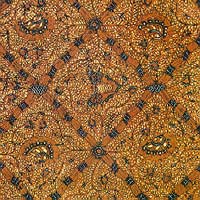
 Kawung is another very old design consisting of intersecting circles, known in Java since at least the thirteenth century. This design has appeared carved into the walls of many temples throughout Java such as Prambanan near Jogjakarta and Kediri in East Java. For many years, this pattern was reserved for the royal court of the Sultan of Jogjakarta. The circles are sometimes embellished inside with two or more small crosses or other ornaments such as intersecting lines or dots. It has been suggested that the ovals might represent flora such as the fruit of the kapok (silk cotton) tree or the aren (sugar palm).
Kawung is another very old design consisting of intersecting circles, known in Java since at least the thirteenth century. This design has appeared carved into the walls of many temples throughout Java such as Prambanan near Jogjakarta and Kediri in East Java. For many years, this pattern was reserved for the royal court of the Sultan of Jogjakarta. The circles are sometimes embellished inside with two or more small crosses or other ornaments such as intersecting lines or dots. It has been suggested that the ovals might represent flora such as the fruit of the kapok (silk cotton) tree or the aren (sugar palm). Ceplok is a general name for a whole series of geometric designs based on squares, rhombs, circles, stars, etc. Although fundamentally geometric, ceplok can also represent abstractions and stylization of flowers, buds, seeds and even animals. Variations in color intensity can create illusions of depth and the overall effect is not unlike medallion patterns seen on Turkish tribal rugs. The Indonesian population is largely Muslim, a religion that forbids the portrayal of animal and human forms in a realistic manner. To get around this prohibition, the batik worker does not attempt to express this matter in a realistic form. A single element of the form is chosen and then that element is repeated again and again in the pattern.
Ceplok is a general name for a whole series of geometric designs based on squares, rhombs, circles, stars, etc. Although fundamentally geometric, ceplok can also represent abstractions and stylization of flowers, buds, seeds and even animals. Variations in color intensity can create illusions of depth and the overall effect is not unlike medallion patterns seen on Turkish tribal rugs. The Indonesian population is largely Muslim, a religion that forbids the portrayal of animal and human forms in a realistic manner. To get around this prohibition, the batik worker does not attempt to express this matter in a realistic form. A single element of the form is chosen and then that element is repeated again and again in the pattern. Parang was once used exclusively by the royal courts of Central Java. It has several suggested meanings such as 'rugged rock', 'knife pattern' or 'broken blade'. The Parang design consists of slanting rows of thick knife-like segments running in parallel diagonal bands. Parang usually alternated with narrower bands in a darker contrasting color. These darker bands contain another design element, a line of lozenge-shaped motifs call mlinjon. There are many variations of this basic striped pattern with its elegant sweeping lines, with over forty parang designs recorded. The most famous is the 'Parang Rusak' which in its most classical form consisting of rows of softly folded parang. This motif also appears in media other than batik, including woodcarving and as ornamentation on gamelan musical instruments.
Parang was once used exclusively by the royal courts of Central Java. It has several suggested meanings such as 'rugged rock', 'knife pattern' or 'broken blade'. The Parang design consists of slanting rows of thick knife-like segments running in parallel diagonal bands. Parang usually alternated with narrower bands in a darker contrasting color. These darker bands contain another design element, a line of lozenge-shaped motifs call mlinjon. There are many variations of this basic striped pattern with its elegant sweeping lines, with over forty parang designs recorded. The most famous is the 'Parang Rusak' which in its most classical form consisting of rows of softly folded parang. This motif also appears in media other than batik, including woodcarving and as ornamentation on gamelan musical instruments. longer dependent on traditional (natural) dyes, as chemical dyes can produce any color that they wish to achieve. Modern batik still utilizes canting and cap to create intricate designs.
longer dependent on traditional (natural) dyes, as chemical dyes can produce any color that they wish to achieve. Modern batik still utilizes canting and cap to create intricate designs. world that is dominated by machines there is an increasing interest in materials that have been handmade. Batik is one of these materials.
world that is dominated by machines there is an increasing interest in materials that have been handmade. Batik is one of these materials.




